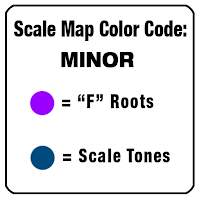Play This Easy Shape ONCE a Day! (HUGE DIFFERENCE)
Understanding the guitar neck is one of the most important things to study as a guitar player. There are several important ideas that need to be explored when it comes to learning the neck and they can include everything from note drills, to shape geometry as well as, scale training...
Ad:
If you've experienced any confusion while trying to learn the neck in the past, or if you feel that you just don’t have the right plan in place when it comes to learning the fingerboard, you really should watch this video.
In it I’m going to show you one scale pattern study that you need to practice on the neck which will instantly help you with any confusion about; note layouts, keys or scale tonality.
This exercise will help you understand short scale patterns and how they can operate regionally across the neck in both Major and Minor. Plus, you'll learn more about; scale location, regional shapes, and tonality, as you realize how easy it can be to develop your true strength for notes and keys all around the guitar.
SCALE TONALITY DRILL:
In this post, I want to show you one thing that you can do every day to help you better understand three ideas;
- your guitar neck
- your key signatures
- Major and Minor tonality
In fact, this exercise is not just easy to learn, but it takes almost no time at all to learn how to play, and it’s so simple that you will probably commit it to memory the first day that you try it.
This exercise involves walking through the first "five notes," of a Major tonality scale section, as well as, doing the same thing through the first "six notes," in the Minor tonality.
How it works, is each scale section will be performed in five different areas of the guitar neck (so you can fully understand how a scale section might be relocated to different octaves and to different ranges of the fingerboard).
If you run the exercise through all the keys over a period of at least three weeks, you’ll find that all of the keys will become better known to you, the notes on the neck for Major and Minor tonality will be much better understood, and the locations of how scales sit all over the guitar will make more sense.
So, let’s get started by learning the first step of this exercise…
Ad:
KNOWING TONALITY:
To start with you’ll need to select a root note and a key signature. Along with that you’ll need to know the parallel scale tones that relate to the Minor scale layout from the chosen root.
For our exercises we’ll select the root note of “F.” This means we’ll need to know all the tones that are found within the “F Major” key and the “F Minor.”
The scale tones for “F Major” are the tones of,
“F, G, A, Bb, C, D, and E.” The scale tones that form, “F Minor” are, “F, G, Ab, Bb, C, Db, and Eb.”
Once you know these scale tones, you’ll want to start the exercise off by working through one of the Tonalities. For our exercise, we’re going to start with the Major Tonality.
Ad:
MAJOR TONALITY:
1). Primary Shape: “F Major” (string 6)
Start by locating the lowest “F” tone, and play the scales first 5 notes.
2). Find the next nearest “F” and play the same shape (string 4)
3). Find the next nearest “F” and play the same shape (string 2)
4). Find the next nearest “F” and play the same shape (string 5)
5). Modified Major Shape - Third String Root
The final shape will need to be modified since we have a tuning
difference between the 3rd to the 2nd guitar string (a “Major 3rd”
instead of a Perfect 4th). The modified shape ends up looking like this.
____________________________________________________
I wanted to take a minute to let you know, that if you want to learn even more about scales and theory I have a great offer for you.
With any donation over $5, or any merchandise purchase from my Tee-Spring store, I’ll send you free copies of THREE of my most popular digital handouts.
One is called, “Harmonized Arpeggio Drills” (it’ll train you on developing your diatonic arpeggios).
Another one is my “Barre Chord” Handout which includes a page showing all the key signatures along with a chord progression that applies barre chords.
Plus, you’ll get my Notation Pack! It has 8 pages of important guitar worksheets for notating anything related to; music charts, guitar chord diagrams, and TAB.
As a BONUS, (from my "Over 40 and Still Can't Play a Scale" video), I'll also throw in a breakdown of all of the chords that are diatonic to the "F Major" scale.
As an EXTRA BONUS for my Phrygian Dominant video, I'll also throw in a breakdown featuring all of the chords that are diatonic to the Phrygian Dominant scale.
Just send me an email off of the contact page of CreativeGuitarStudio.com to let me know about either your donation or your Merchandise purchase and I’ll email you those digital handouts within 24 hrs.
____________________________________________________
I wanted to take a minute to let you know, that if you want to learn even more about scales and theory I have a great offer for you.
With any donation over $5, or any merchandise purchase from my Tee-Spring store, I’ll send you free copies of THREE of my most popular digital handouts.
One is called, “Harmonized Arpeggio Drills” (it’ll train you on developing your diatonic arpeggios).
Another one is my “Barre Chord” Handout which includes a page showing all the key signatures along with a chord progression that applies barre chords.
Plus, you’ll get my Notation Pack! It has 8 pages of important guitar worksheets for notating anything related to; music charts, guitar chord diagrams, and TAB.
As a BONUS, (from my "Over 40 and Still Can't Play a Scale" video), I'll also throw in a breakdown of all of the chords that are diatonic to the "F Major" scale.
As an EXTRA BONUS for my Phrygian Dominant video, I'll also throw in a breakdown featuring all of the chords that are diatonic to the Phrygian Dominant scale.
Just send me an email off of the contact page of CreativeGuitarStudio.com to let me know about either your donation or your Merchandise purchase and I’ll email you those digital handouts within 24 hrs.
____________________________________________________
MINOR TONALITY:
1). Primary Shape: “F Minor” (string 6)
Start by locating the lowest “F” tone, and play the scales first 6 notes.
2). Find the next nearest “F” and play the same shape (string 4)
3). Find the next nearest “F” and play the same shape (string 2)
4). Find the next nearest “F” and play the same shape (string 5)
5). Modified Minor Shape - Third String Root
The final shape will again need to be modified since we have the tuning difference existing between the 3rd to the 2nd guitar string (a “Major 3rd” instead of a Perfect 4th).
Ad:
CONCLUSION:
If you’re somebody who doesn’t know their key signatures, or if you really don’t comprehend why a scale is Major or Minor.
Or, if you’ve never taken the time to learn very much about fret-board range (or exactly where the different octave layouts of root notes are on the neck), then this lesson will go a very long way to helping you learn all of this stuff.
The fret-board doesn’t have to be confusing. All of the scale tones and root notes will always form unique geometrical patterns on the neck.
All you need to do is continuously run through new note layouts for new shapes and new patterns for scales so that you begin getting a very good orientation for exactly how this stuff works on the guitar.
Your entire guitar neck will start making a whole lot more sense to you when it comes time to strum chords and play solos.
___________________________________________________
GET GOOD NOW - JOIN THE MEMBERS AREA
Guitar Chords | F Chord | Guitar Notes | G Chord | C Chord | D Chord | Guitar String Notes





















